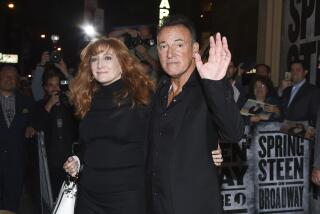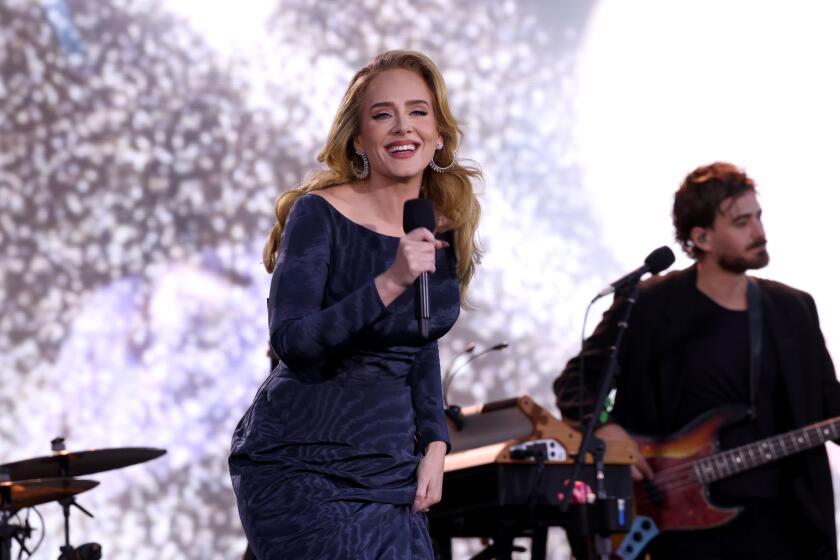Thunder mode
The moment the lights went down Monday night at the L.A. Sports Arena for Bruce Springsteen & the E Street Band’s return to a Southland concert stage, a vintage-looking calliope surfaced from beneath that stage playing not just any vintage-sounding midway number but “That Daring Young Man on the Flying Trapeze.”
At 58, Springsteen certainly can’t call himself young anymore -- at least not chronologically. Despite the hurricane force he and the E Street Band frequently mustered during their two-hour show, plenty of fans cheering them on no doubt could recall the nights of yore when this fabled group was just starting to break a sweat at the two-hour mark.
Still, what this outfit does on stage each night remains fairly daring, and the older they get, the greater the risk of the without-a-net abandon with which they administer the sacrament of rock ‘n’ roll.
The invigorating thing about the New Jersey bard is the way he and his merry band embrace their second coming of age. For all the kudos Springsteen’s new “Magic” album is earning for the joyful rocking it delivers, it’s rife with self-doubt, disillusionment, anger and acceptance of the disappointments and compromises life inevitably presents the thinking person.
“I’m trying to find my way home,” Springsteen sang as he opened the show with his latest single, “Radio Nowhere,” a song that taps into the classic-rock musical lexicon of Blue Oyster Cult’s “Don’t Fear the Reaper” as well as Tommy Tutone’s “867-5309/Jenny.”
Over the course of the night it became more apparent that the search he’s on -- and he’s intent on bringing those who will listen with him -- is for the core values he had the luxury of taking for granted once upon a time, in less-conflicted days.
Springsteen is too observant to look back with simple nostalgia on the glory days of a different era. He knows the difference is the result of individual experience and growth, not the societal or political changes around him, though he had some choice, well-publicized words on that front too. But by following “Radio Nowhere” with “No Surrender,” he put the youthful purity of that 23-year-old song into high relief against the portrait of alienation of a man closing in on 60.
“Girls in Their Summer Clothes,” a pop confection crafted on the Spector-Shirelles-Brian Wilson blueprint, could be sung by anyone half Springsteen’s age, but it would lose the melancholy of his recognition that those girls, and time, are passing him by. He’s no longera participant in that momentof life but an observer lookingin.
Throughout the show it was less about individual performances than the context in which Springsteen places his new and old songs. “Girls” came between “Badlands” and the very early “Thundercrack,” a celebration of raging hormones that’s now virtually a distant memory for him and his peers.
Much of his music in recent years has wrestled with the dilemma of reconciling reality against youthful fantasy of how the world ought to be. And with real-world examples of fading ideals and loss of faith all too easy to spot, it’s a dilemma with no quick fix.
“We’ve seen things happening that shouldn’t be happening,” he said as he introduced another of the “Magic” songs, “Living in the Future.” “Tonight we’re going to do something about it. We’re going to sing about it. That’s what we do because we’re musicians. But it’s a start.”
That start clearly is a source of liberation for the members of the mighty E Street Band, especially in light of the treatment they were afforded on “Magic” by producer Brendan O’Brien. This band has a sound that’s bigger than a Cadillac, but O’Brien has compressed it into a sonic Subaru on much of the album. The aural space the band got live brought back the grandeur of the E Street sound.
Clarence Clemons bade most of his stage time tapping tambourines or valiantly rattling maracas between infrequent sax solos, most of which allowed him only to re-create for the umpteenth time a classic riff from a long-ago recording session. Guitarists Steve Van Zandt and Nils Lofgren got considerably more opportunity to enter into the musical dialogue with their Boss, spinning out searing solos that elevated the dialogue ever higher.
As if to tease those who bypassed his “Seeger Sessions” album and tour because it jettisoned the E Street Band to explore old folk songs rather than new Springsteen tunes, he closed with the E Streeters’ take on that sound for the final number, “American Land,” which toasts this nation’s defining immigrant history and quickly scolds those who would mon- key with the melting-pot tradition.
The phalanx of electric guitars, swirling keyboards and pounding piano gave way to dual accordions, acoustic guitars, mandolin and Clemons wrapping his meaty fingers around a tiny tin whistle for the Irish-rooted tune. It was Dylan’s electric revolution in reverse, Springsteen restating the power of folk music after an evening of plugged-in mayhem.
The kind of thing you might expect from a daring young man.
--
More to Read
The biggest entertainment stories
Get our big stories about Hollywood, film, television, music, arts, culture and more right in your inbox as soon as they publish.
You may occasionally receive promotional content from the Los Angeles Times.










